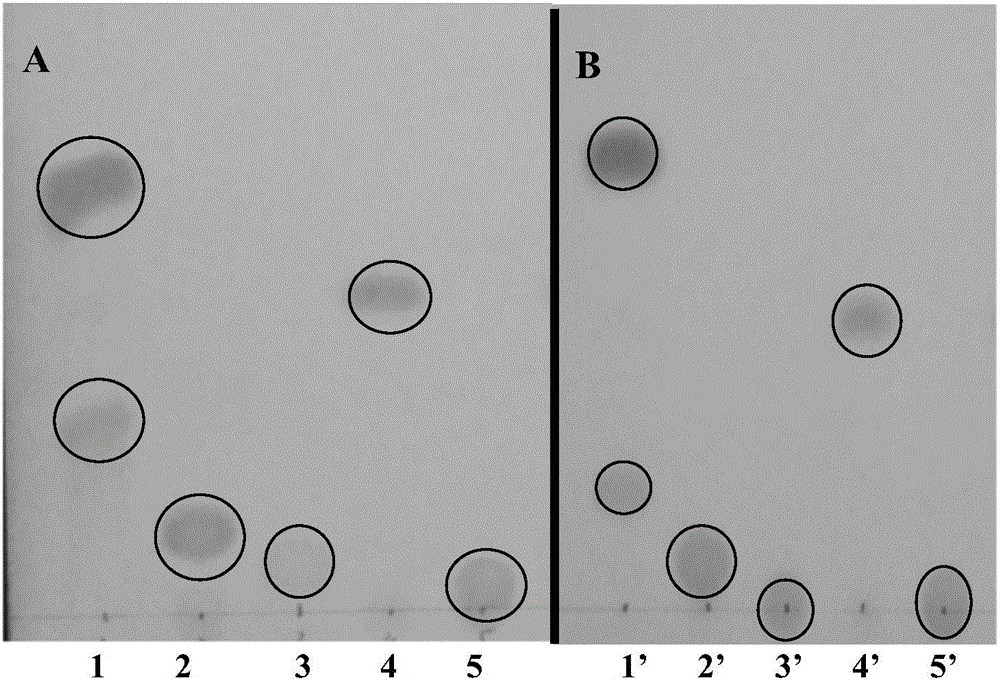Method for detecting N-acyl-homoserine lactone quorum sensing signal molecules in sample
A quorum sensing signal and homoserine technology, applied in the biological field, can solve problems such as being vulnerable to antibiotics, thin bacterial biofilms, and reduced ability to synthesize bacterial biofilms, achieving high repeatability, high fidelity, and uniform thickness Effect
- Summary
- Abstract
- Description
- Claims
- Application Information
AI Technical Summary
Problems solved by technology
Method used
Image
Examples
Embodiment 1
[0035] The preparation of the bacterial strain used in embodiment 1, material, reagent
[0036] In the following examples, the N-acyl-homoserine lactones (AHL) quorum-sensing signal molecule detection strain used is Agrobacterium tumefaciens A136 (pCF218) (pCF372), and the culture condition is LB+spectinomycin Sp (50 micrograms / ml)+tetracycline Tc (4.5 micrograms / ml).
[0037] Another strain used was Pseudomonas aeruginosa P. aeruginosa PAO1, which has the ability to produce C4 and 3-oxo-C12AHL.
[0038] Spectinomycin Sp, tetracycline Tc, X-gal (5-bromo 4-chloro 3-indole β-galactoside), AHL standard C6 (product number 10940-25MG), C8 (product number 17247-25MG), C11 ( Product No. 10937-25MG) and C14-HSL (Product No. 09139-25MG) were purchased from Sigma, and RP-C18F254s thin-layer chromatography plate (TLC plate) was purchased from Merck, Germany.
[0039] The preparation process of LB liquid (Luria-Bertani) medium is as follows: accurately weigh 1.0 g of peptone (Typtone),...
Embodiment 2
[0042] Example 2 is compared with the existing thin-layer chromatography for detecting AHL signal molecules in samples
[0043] Existing thin-layer chromatography methods for detecting AHL signal molecules in samples are as follows:
[0044] (1) Put 2-3 microliters of AHL standard sample on RP-C18F254s thin-layer chromatography plate (20*20cm), fully develop with methanol / water (60:40, v / v) as mobile phase, evaporate Dry solvent.
[0045] (2) According to the classic literature (Kendra P.Rumbaugh (ed.), Quorum Sensing: Methods and Protocols, Methods in Molecular Biology, vol.692, DOI 10.1007 / 978-1-60761-971-0_1, Springer Science Business Media , LLC 2011) method of thin-layer chromatography to prepare the upper semi-solid medium, spread on the TLC plate. The preparation method is as follows: configure 50mL semi-solid LB medium, after high-pressure steam sterilization, cool down to about 45°C (to avoid agar from congealing), and insert 3mL of A136 strain cultured overnight in...
Embodiment 3
[0057] Example 3 Extraction of Pseudomonas aeruginosa P.aeruginosa PAO1 AHL signal molecule and detection of this extract
[0058] The inventors extracted Pseudomonas aeruginosa P.aeruginosa PAO1 AHL signal molecule through the following operations:
[0059] (1) Inoculate the monoclonal PAO1 strain in 10mL liquid LB medium, cultivate overnight to obtain the first-grade seeds, then add the first-grade seeds to the Erlenmeyer flask containing 500mL sterile LB liquid medium for expansion culture, and expand the culture It was cultivated at 30°C and 220r / min for 24h.
[0060] (2) The fermentation broth was centrifuged at 4°C for 20 min at a centrifugation speed of 6000 g / min.
[0061] (3) Collect the supernatant, and filter the centrifuged supernatant with a 0.22 micron filter membrane to further remove impurities.
[0062] (4) In a 1L separatory funnel, mix the collected fermentation supernatant with ethyl acetate at a volume ratio of 1:1, turn it upside down several times ever...
PUM
| Property | Measurement | Unit |
|---|---|---|
| thickness | aaaaa | aaaaa |
| height | aaaaa | aaaaa |
| height | aaaaa | aaaaa |
Abstract
Description
Claims
Application Information
 Login to View More
Login to View More - R&D
- Intellectual Property
- Life Sciences
- Materials
- Tech Scout
- Unparalleled Data Quality
- Higher Quality Content
- 60% Fewer Hallucinations
Browse by: Latest US Patents, China's latest patents, Technical Efficacy Thesaurus, Application Domain, Technology Topic, Popular Technical Reports.
© 2025 PatSnap. All rights reserved.Legal|Privacy policy|Modern Slavery Act Transparency Statement|Sitemap|About US| Contact US: help@patsnap.com



